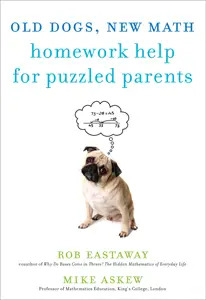Tame the jitters you feel when your child asks for help with the math homework that looks oh-so-different than you remember. Rob Eastaway and Mike Askew decode the “new math” in their new book Old Dogs, New Math: Homework Help for Puzzled Parent. Read their tips to help you help your child.

It's the moment that many parents dread: “Can you help me with my math homework?” Many years, perhaps decades, ago, you went through all this as a child yourself, of course. But it feels very different when you're the one from whom help is being sought. And in any case, things have changed: the math has changed, the methods have changed, and perhaps the attitudes of children to their parents have changed. That's certainly what parents say, though parents may have been saying this for centuries.
Of all the subjects covered at school, math is the one that worries parents the most. We've met many a parent whose concern is that their child is beginning to bring home work that the parent can't do. But there are many parents who are at least competent, often very good, at math, and they have a different worry. The problem is: They do it differently at school these days. Attempts by Dad to demonstrate subtraction by adding one and paying ten at the bottom are met by a glazed look from a bewildered child, who finally goes to Mom saying, “Dad is just confusing me.”
RELATED | The Best Math Videos for Kids
Do they (or I) really need to know this?
Some math is very easy to justify because it has obvious applications in life. The problems begin to arise with math that is more abstract. When are they going to need to know about prime numbers? How could knowing the internal angles of a pentagon ever be of practical use to them?
The best response to “What's the point?” is often to answer it with another question: “Why does there have to be a point?” What's the point of a Sudoku? There isn't one, yet that doesn't stop millions of people from doing them, and enjoying it too. Is there a “point” to reading poetry? While part of the “point” of math is to give your children practical skills that they can carry on into adult life, actually the relevance doesn't matter if they are enjoying themselves. And enjoyment doesn't have to mean a laugh a minute. Playing football, climbing a mountain, and many other enjoyable pursuits usually feature many moments of discomfort, frustration, even pain, but without them the whole experience would be less rewarding.
Why it's done differently these days
In most schools, the days are gone when math lessons were endless pages of sums to be done in silence, using techniques for addition and multiplication that dated back hundreds of years. Today's lessons are much more about collaboration and investigation. Long periods of silence are rare, even in math lessons.
The techniques have changed, too. One example of how things have changed is the way that children perform a large multiplication such as 79 × 43. Most parents were taught the method of “long multiplication,” and many still use it to do calculations on the back of an envelope. However, there aren't many parents who can explain why it works. It is, if you like, a black box for which you turn the handle and the correct answer comes out at the far end (you hope). Today, the emphasis in schools is on teaching methods that help children to understand the underlying math, thus (in theory) reducing the chance of their making mistakes, and building a foundation for understanding more complicated mathematics later on.
This move from learning techniques—learning how—to understanding the math behind them—learning why—came about for several reasons. Firstly, it was realized that there wasn't a halcyon time when everybody left elementary school able to perfectly carry out long multiplication, long division, and so on. Surveys into levels of adult understanding knocked this myth on the head.
Secondly, technology is changing the world we live in at an increasingly rapid rate. Calculators have taken over slide rules and tables of logarithms. The number of times that anyone in their everyday lives actually needs to do a long division or long multiplication has dramatically decreased. But the need for knowledge of when to multiply or divide has increased (Which supermarket offer gives me the best value? Which deal on that car is better?), and we need to be confident that the answers provided by a spreadsheet or calculator are reasonable ones. Today, children are still taught paper-and-pencil techniques, but these are closer to “back of the envelope” methods that confident mathematicians use.
These techniques are not just about getting the right answer (the calculator is far and away the most sensible tool for that) but about helping children develop insight into mathematics, helping them to develop number sense. As one writer, Richard Skemp, puts it, it's the difference between providing someone with a list of instructions for getting from A to B and providing them with a map. With a list of instructions, making a mistake can send you down the wrong path and it's difficult to get back on track. With a map you can plot your own most sensible route through. Math instruction these days tries to help children develop mathematical maps rather than remember lists of directions.
RELATED | 10 Fun & Educational Learning Apps for Kids
As a parent, it is important that you learn about the new techniques. The ones you really need to know are the partial products or grid method for multiplication, the partial division or grouping method for division, and the notion of the number line and how it is used. There's also some unfamiliar terminology that you'll want to get familiar with, because children are now having to learn and use terms like decomposing and array.*
You can at least take comfort from the fact that while some of the techniques being used in school today may have new names, such as the compensation method, the techniques themselves are ancient. Indeed, some of them predate the techniques that you learned at school yourself. The Romans and Egyptians used a form of decomposing to add numbers quickly, and now your children are doing it too. Don't be blinded by the jargon that goes with all of these new methods – the principles are very straightforward, and very old.
And the other good news is that, as children progress up the mathematical ladder, all of the techniques eventually join up with the ones that you did at school. Once they are confident in multiplication, for example, your children should be doing long multiplication calculations just like the ones you are used to.
How can I encourage my child to enjoy math?
Much of your child's enjoyment and development in math will depend on the experience they have at home. You should praise your children for the effort they put into the math, rather than for being “smart” or “quick.”
An ideal time for giving feedback is when you are working through your child's homework together. When a child gives a wrong answer to a math question, it's tempting to immediately tell them they have made a mistake and to then explain the right answer. Resist that temptation. Ask them to talk through how they worked it out, and lead them on until they spot the error.
And when your child gets some math right, ask them to explain their work then, too! This gives you a chance to check their reasoning (sometimes people come up with the right answer for the wrong reasons), but it does something more important, too. If you only ask for an explanation when they get the question wrong, they begin to associate being asked to explain with failure, and so will start to clam up rather than reveal their mistakes. As a parent, you don't have a hope of helping them to reason if they won't reveal their thought processes.
Be tolerant of your child getting stuck. It's very easy when working one-to-one to think, “I have to get the point across.” Learning does not happen in an instant. Taking a break, coming back to something the following day, or leaving it for a week or so can do wonders for understanding – and tempers.
Above all, never describe yourself as “hopeless” at math. This is our biggest “don't.” If you show interest in math, your children will become curious too, and by talking about and playing with math as a natural part of your daily life rather than it being something that's only done under duress when sitting at the table doing homework, your child is bound to enjoy it more.
Excerpted from Old Dogs, New Math: Homework Help for Puzzled Parents, copyright © Rob Eastaway and Mike Askew, 2010. Published September 2010; reprinted by permission of the publisher, The Experiment, LLC.
*“Old Dogs, New Math” teaches all these concepts in easy-to-follow and specific ways, and has a helpful glossary to help you with particular terms that may cause you concern.
Also see: Educational Gift Ideas for Kids



















